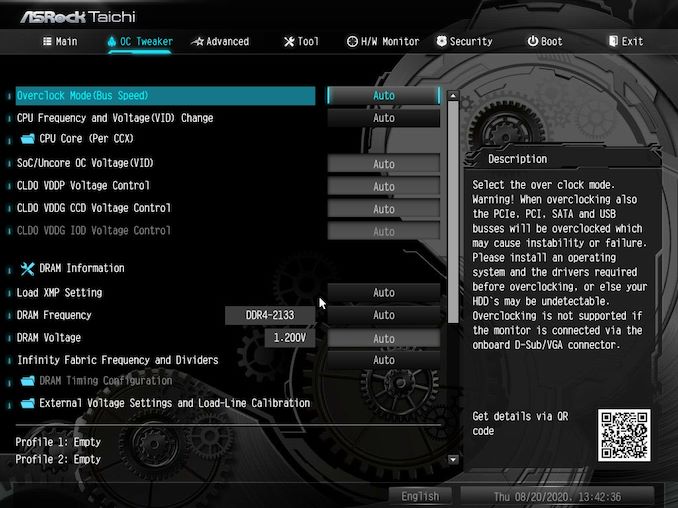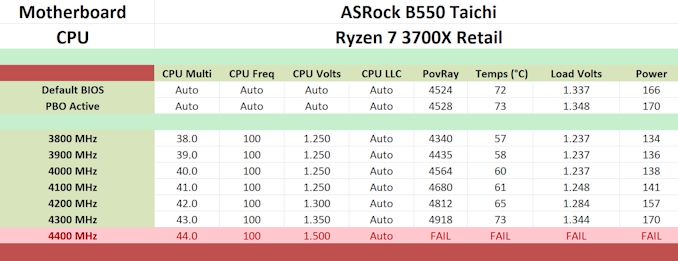ASRock B550 Taichi Review: The $300 B550 Motherboard with Chutzpah
by Gavin Bonshor on August 21, 2020 3:30 PM EST- Posted in
- Motherboards
- AMD
- ASRock
- Taichi
- AM4
- Ryzen 3000
- Ryzen 3700X
- Ryzen 4000
- B550
- B550 Taichi
Overclocking Ryzen 3000
Experience with the ASRock B550 Taichi
It's no secret that AMD's Ryzen 3000 processors run hot on basic air cooling thanks to the highly-dense cores packaged onto its 7 nm chiplets. For our testbed Ryzen 7 3700X processor with 8-cores and 16-threads, the key to unlocking the extra performance available with Ryzen 3000 is down to the cooling, with custom water cooling and good quality AIO coolers handling AMD's Precision Boost Overdrive a little better. Another way to squeeze out extra system performance is via the memory, although Ryzen 3000 works optimally with DDR4-3600, with an Infinity Fabric or FCLK clock speed of 1800 MHz. This is what most Ryzen 3000 silicon can manage without instability issues.
Using the ASRock B550 Taichi's firmware to overclock our Ryzen 7 3700X processor was straight forward. All of the boards overclocking settings are within the OC Tweaker setting and includes everything needed to overclock both the CPU and memory. Under the CPU frequency and Voltage (VID) change option, users can dial in a ratio in 100 MHz increments, eg 4.3 for 4.30 GHz. Underneath this is the option to change the CPU core frequency, although we find it best to remain under 1.45 V for the longevity of the silicon. The range of CPU core voltage also relies on the cooling method used, with better cooling allowing for sustained performance without the risk of thermally throttling the CPU cores.
Other important options include a dedicated section for customizing memory latencies, with extensive options available. For users looking to overclock memory to its rated specifications via X.M.P 2.0 profiles, they can simply select the relevant profile, although some memory kits sometimes come with more than one profile. Setting the Infinity Fabric Frequency is equally important, which we recommend stays below 1800 MHz and it works best at half the memory speed, eg, 1800 MHz on the FCLK for DDR4-3600, and 1600 MHz for DDR4-3200.
Overclocking Methodology
Our standard overclocking methodology is as follows. We select the automatic overclock options and test for stability with POV-Ray and OCCT to simulate high-end workloads. These stability tests aim to catch any immediate causes for memory or CPU errors.
For manual overclocks, based on the information gathered from the previous testing, starts off at a nominal voltage and CPU multiplier, and the multiplier is increased until the stability tests are failed. The CPU voltage is increased gradually until the stability tests are passed, and the process repeated until the motherboard reduces the multiplier automatically (due to safety protocol) or the CPU temperature reaches a stupidly high level (105ºC+). Our testbed is not in a case, which should push overclocks higher with fresher (cooler) air.
We overclock with the Ryzen 7 3700X, for consistency with our previous overclocking tests.
Overclocking Results
Performing our usual method of overclocking shows the ASRock B550 Taichi is a very capable motherboard for users looking to capitalize on AMD's unlocked AM4 series models such as B550 and X570. The default settings include AMD's Precision Boost Overdrive active so users are getting the best-case scenario without factoring in memory. The maximum stable overclock we managed to achieve with our Ryzen 7 3700X processor was 4.3 GHz at 1.350 V on the CPU VCore. This is equal to the best overclock we have managed on any AM4 model tested so far.
Overclocking manually from 3.8 to 4.3 GHz, we saw a gradual and expected increase in POV-Ray performance, with an equally expected increase in temperature as we increased the CPU VCore voltage. In regards to CPU Vcore voltage set manually in the firmware in comparison to CPU VCore under load, we found the B550 Taichi to have solid VDroop control with the Load-Line Calibration or LLC settings left at default. One benefit to the ASRock firmware is that it would under volt slightly which should slightly reduce temperature and power consumption, although the difference is marginal at best. We did try and achieve a maximum overclock of 4.4 GHz with 1.50 VCore to see if it would run, but this was unstable and is down to a limit of our silicon as opposed to the board itself.












61 Comments
View All Comments
Gigaplex - Wednesday, August 26, 2020 - link
The uncertainty certainly is annoying, but if I bought that board and then some time later had a need to install a PCIe x8 card, I'd be a bit frustrated.(I installed an LSI 9207-8i about a month ago on a motherboard I've had for >8 years, it was lucky I had an x16 slot free)
Tpoking - Saturday, August 22, 2020 - link
What's that old saying "Intel tax"? Try AMD tax only your getting less for more with this abomination and any AMD it's build over the past two months. Excuses with current event don't stick comparing the other way around. AMD is not value when considering anything but budget Matx boards and last Feb choosers.antonkochubey - Saturday, August 22, 2020 - link
Yeaaaah because Z490 boards (B550 is equivalent to Z490 - allows x8/x8 split, has PCIe 3.0, allows overclocking) can be found for $42 or for free on the side of the road /sSpunjji - Monday, August 24, 2020 - link
Great post, next time try adding some facts.Oxford Guy - Saturday, August 22, 2020 - link
Let's see...Midrange chipset at premium price, for no justifiable reason? Check.
Tons of VRM phases for CPUs that shouldn't even be overclocked? Check.
Excuses? Hmm...
antonkochubey - Sunday, August 23, 2020 - link
This midrange chipset matches Intel's highest-end chipset in it's feature set, and exceeds in some (PCIe 4.0 and CPU-direct first M.2).MrVibrato - Sunday, August 23, 2020 - link
I think it will be easier for you to use your fingers when counting PCI lanes.Spunjji - Monday, August 24, 2020 - link
The VRM thing really bugs me.lorribot - Sunday, August 23, 2020 - link
Why?Why 2.5GbE? No routers supplied by ISPs support this so yuo would need to spend a stack on a seperate switch. I am not entirely sure what the use case would be for 2.GbE and what sort of data would need to be transferred over that link. When there is also a top end WiFi 6 built in as well. One or other of these expensive features will be unused.
This board, like many of the B550 boards, makes no sense except in very few use cases, noise or heat, over an X570 based board that brings more future proofed support for PCI 4.
the top price for a B550 board should be around £/$70-100 and no more but there is massive shortage of boards in that price bracket.
A £/$75 board would give a good entry in to AM4 for those still on old Haswell/Broadwell CPUs still looking for a value upgrade path in the AMD productstack.
Gigaplex - Sunday, August 23, 2020 - link
I use 2.5GbE. Gigabit is the single biggest bottleneck for NAS speeds. I use a single SSD in my system, mass storage is on the NAS. I don't want a loud mechanical drive sitting right next to me. I also don't even have a switch, I connect the two endpoints directly.Switches aren't going to be commonly available at a low price until 2.5GbE is ubiquitous. For that to happen there's going to be a period of time where some people like you keep complaining about having faster ports with nothing to plug in to.
You want the cheap motherboards you're asking for? A520 is for you.